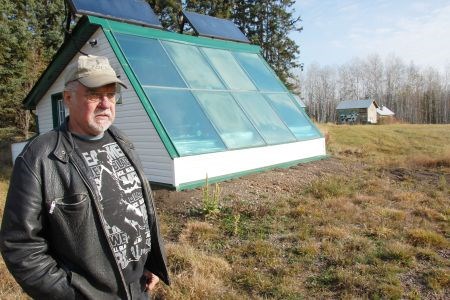Like many of the Finnish immigrants who settled west of Thunder Bay at the turn of the last century, Leo Hunnakko is a big believer in being self-sufficient.
The Thunder Bay area entrepreneur believes being located in a northern climate shouldn't be a restriction to growing food year-round.
Hunnakko has developed a home-grown solution that could bring relief to remote First Nation communities.
While commercial growers in Thunder Bay start planting in March, Hunnakko has found a way to extend the growing season with an experimental greenhouse that works even in the coldest temperatures.
And what it runs on is the area's abundant sunshine.
“In this region, we're virtually the sunshine capital of Canada,” said Hunnakko, who calculates Thunder Bay receives about 340 hours of sunshine between December and February.
It's what spurred him to build a solar-powered greenhouse prototype in 2009 where he has been harvesting tomatoes, lettuce, broccoli, cucumbers and specialty herbs such as Thai basil, sage and rosemary.
The surplus produce is sold at local markets, including wheat grass which he juices and sells as a highly nutritious frozen drink at health food stores.
His greenhouse – dubbed GH 365 – is located at his family's homestead in Nolalu, about a hour's drive west of Thunder Bay.
Hunnakko, who ran a granary in Port Hope before moving back north, has fashioned his inter est in greenhouses into an enterprise. So far, he's consulted and project-managed five structures and eventually wants to mass produce them.
In the beginning, he just wanted one for himself.
But it also got him thinking about the challenges faced by remote First Nation communities who must airlift groceries in and don't always have access to most nutritious and affordable food.
His research of cold climate greenhouses produced scant information.
He sought advice from a local commercial tomato grower and even tapped into the brainpower at the University of Manitoba's Faculty of Biosystems Engineering. Researchers there have been experimenting with greenhouses using heat retention walls, thermal blinds and wood stoves for supplementary heating.
Hunnakko has worked some of those components into his 18-by-22 foot prototype with some funding from the federal Industrial Research Assistance Program.
Hunnakko said there's nothing overly scientific about it except that it's a greenhouse that works year-round.
The south-facing windows are glazed and angled back at 36 degrees. It's ideal for maximizing the heat from the winter sun, which travels at 15-18 degrees above the horizon in northwestern Ontario.
The greenhouse runs on circulating systems with a glycol-water mix that flows up to two rooftop solar panels and into a heat exchange unit attached to a hot water tank.
A thermostatically-controlled pump circulates water into tubing interwoven into heat retention walls which radiate warmth at night. Warm water is also pumped into the planter tables and into the dirt floor for radiant heating.
In case of a system failure, a solar thermal tank acts as a backup, but a propane or wood pellet stove could be used.
“Essentially it's a big heat sink. I've tried to design this to be as self-regulating and self-functioning as possible.”
There were some close calls during the field test.
“One morning I got up and it was minus 30, and got my boots and came in here expecting the plants to be limp. But it was about 5.6 degrees above and the plants were fine. So that was a good test.”
He's promoting the idea of attaching greenhouses to the south side of a home, barn or community centre, which, depending on size, could range in price between $19,000 and $29,000.
The idea seems to be drawing some outside interest.
Hunnakko said the greenhouse is ideal for growing native plants used in Aboriginal healing practices which is exactly what's behind a 46-by-26 foot project he is managing for a Thunder Bay resident, who is a noted specialist in medicinal plants and herbs.
For remote communities, Hunnakko said a large greenhouse could be built as a centrally-located food distribution centre.
He's also talked with a local modular home builder to investigate where the structures can be rolled out in assembly line-fashion as a pre-fabricated structure.
Hunnakko said First Nation chiefs from Red Rock and Muskat Dam have visited and he's taken meetings with the Nishnawbe Aski Development Fund and FedNor officials.
But he classifies those discussions as being only at the exploratory stage.




